Himalayan Singing Bowls
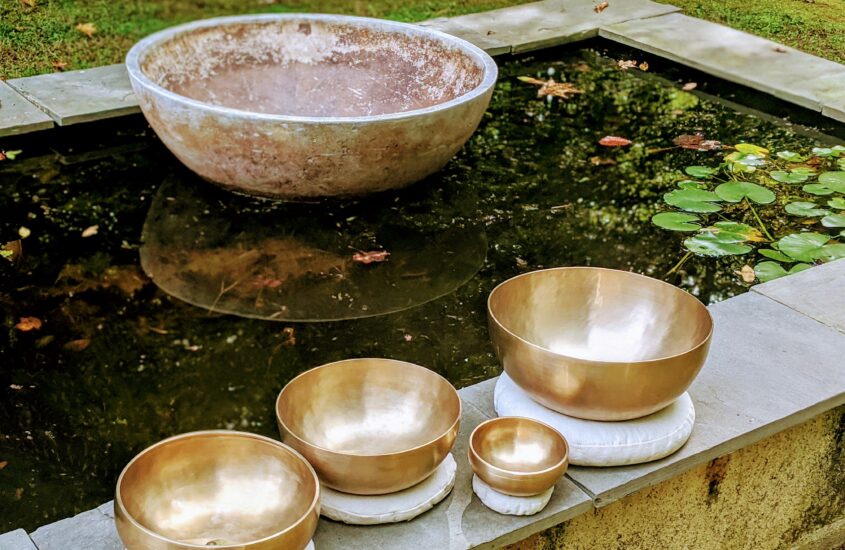
Meet the Voices Series
In this installment of Meet the Voices, we will introduce and give overview of alloy singing bowls and their place in the soundscapes at Ancient Song Therapy. Brief notes will be given on their origins and history, the science behind their complex frequencies, and the health benefits of these instruments.
What are Himalayan Singing Bowls?
Alloy singing bowls, sometimes called Himalayan or Tibetan singing bowls, are popular tools for the sound therapist. Most often made of a combination of various metals, known as an alloy, the frequencies produced can range from bell-like to muted, single toned to tones with complex harmonics. It all depends on the metals used, as well as the shape and technique of a bowls’ construction. Their application extends beyond their use as instruments, as we will discover.
Unlike crystal singing bowls, alloy singing bowls truly have an ancient history. While it is most likely these vessels originated for practical uses (serving and eating bowls, or scoops for measuring grain), evidence of the first bronze standing bells, called nao, date back to the Shang dynasty in China (16th – 11th centuries BCE). These early bells were mounted on a stem and struck on the rim with a mallet. Evidence that they may have been produced in sets of three exists, and notation that bells struck on different points would create different ringing tones.
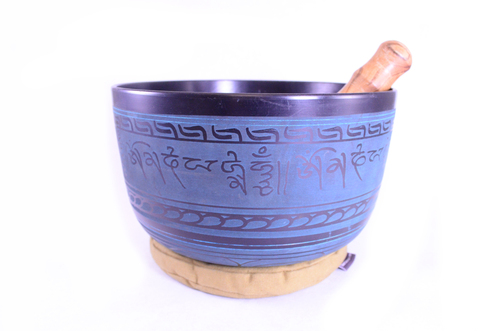
Alloy bowls are made in modern times using various methods. Some are cast, often necessitating a higher content of iron the larger the bell. Cast singing bowls are readily available on the market, and often have bas relief designs that can include mantra or glyphs. Aluminum cast bowls are also quite easily found, often inexpensively, and have clear tones and quick decay. These come in a variety of colors and are often tunes to the chakra theory, bearing colors and symbols accordingly.
The idea of “Tibetan Singing Bowls” is a modern concept, and one that originates strictly in The West. The hand-pounded, alloy bowls made in Tibet and the Himalayan plateau including Nepal and Northern India, were initially constructed as food vessels. There is no evidence in writings about Tibetan music or ritual that alloy bowls were ever historically used for “singing.” Many high-priced antique bronze bowls from Tibet may indeed have a lovely sound quality, but this is secondary to its original use on the tabletop.
The specific Himalayan bowls used by Ancient Song Therapy in our sonic ceremonies are different from all of the above mentioned bowls. Zen Therapeutic Bowls are created for vibration above audible sound. They are handmade in Nepal, from alloy consisting of mostly bronze and tin, with a few others. Their shape is specifically designed to send vibrational energies down into the base of the bowl, where it contacts the body. Zen bowls are used in Vibrational Sound Therapy (VST), though the bowls Jenn has chosen also have pleasant sonic resonance and can be heard in a room during a sound bath as well. Their frequencies are rich and full or harmonics when struck or “sung” with a friction mallet. The character of the bowls is warm and supportive, evocative of the earth itself.

Jenn currently employs the following bowls in ceremony: 2000g–deep, low resonance, used most often to root and embody and often an accompaniment to overtone singing; 1300g–mid-high-tone, rich and honey-like on initial strike, but can reach high, bell-like harmonics when played near the rim; 900g–mid-tone and the most gong-like, highly vibratory and not often played in sound baths unless struck as a bell; 300g–high and chime-like, most often this is the opening tone, the call to presence, long sustain.
Health Benefits of Alloy Singing Bowls
There has been much research in to these sound therapy tools, even more so than has been done on crystal bowls. This is, in part, due to the complexity of their vibrational frequencies.
An observational study published in 2016 by The Journal of Evidence-Based Complementary & Alternative Medicine, discusses the effect of Tibetan bowls on mood, anxiety, pain, and “spiritual well-being,” and how stress and tension in the body have been linked to diseases such as heart disease, diabetes, addiction and issues of mental health. The report showed a significant increase in “spiritual well-being” after exposure to this type of meditation.
Enter your quote textParticipants aged 40 to 59 years appeared to especially benefit from the sound meditation. This age group demonstrated the largest reduction in physical pain and a strong reduction in tension, especially for those who were previously naïve to this type of meditation
Tamara Goldsby, PhD
The how and why this modality is effective is more elusive. Researchers from the Institute of Physics sought to better understand alloys used in Tibetan bowls by observing the effects of their vibrational frequencies on water (which comprises about 70% of the human body). The effects can be seen in this short video. The results are dramatic.
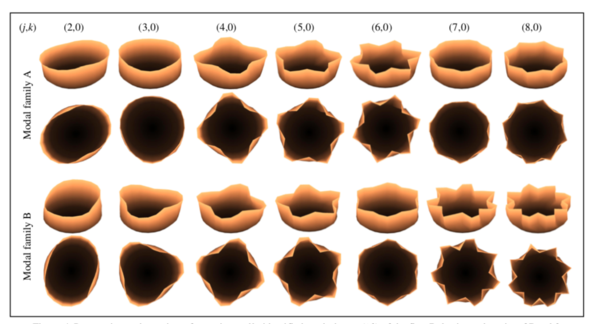
What’s more, it has been discovered that the rim of the bowl itself change shape, which implies that the alloy bowls reach fluid states at certain vibrations, as discussed in The Dynamics of Tibetan Singing Bowls, and again here. While these observations have not directly translated into resesearch into the true physical effects of these vibrations on the human body, the effects of the relaxation response and entrainment of regular sound therapy sessions do have an effect on stress and tension in the body, and the mind-body connection has been studied at great length.
Self-care is health care. A sound bath or meditation is an opportunity for recuperation, integration, and ease. It is time gifted to oneself that announces I am worth taking care of. Self-care is a radical act, an act of reclaiming the self from the clutches of societal expectations, which so often are completely unrealistic. We will go in depth on the science of sound therapy in future articles, but here are some of the benefits of adopting a meditative self-care practice:
- Rest and Relaxation – Our minds are constantly processing thoughts, information arrives to us at a rate that is impossible to digest it all, and we are often existing in a state of overwhelm, distraction, and decision fatigue. Meditative practice, one supported by sound, can help stop thoughts in their tracks by offering a focal point that allows the body to deeply relax. Restorative practices such as this has been shown to effectively reduce stress and anxiety (thoughts), relieve physical pain, improve mental and emotional clarity, stimulate the immune system. Ultimately, sound therapy allows one to be fully present in the moment.
- Frequency facilitates healing – Sound therapy and meditation can help free up energy in the body, especially that which is stuck in the mind in the form of thoughts, stress, and anxiety, and create a greater capacity for awareness and management of these emotions. When we are less stressed, our immune system is less tasked. When our immune system is running at full strength, we can heal, or remain healthy. With repetition (frequency), we entrain ourselves to the feeling of relaxation, that feeling of balance and harmony, and are more keenly aware when our body informs us that there is something out of balance. We teach ourselves how feeling better feels.
- Improved sleep – By relaxing our body and mind, letting go of stress and worries, we can attain the ultimate restorative practice—sleep. When we achieve between 6-8 uninterrupted hours of sleep, a cycle in which N-REM and REM states are reached, our body systems are revived and restored, we can stave off disease, and feel more vital and healthy.
Conclusion
Alloy singing bowls are a powerful tool for facilitating an environment for meditative practice, relaxation and restorative self-care. Their clear, consistent tones can have profound effects on the body, mind and spirit. When our bodies learn how to be free from stress, even for an hour, we teach ourselves how to listen to our bodies during times of disease and disharmony so we can quickly and efficiently return to our natural, resonant state, at peace.
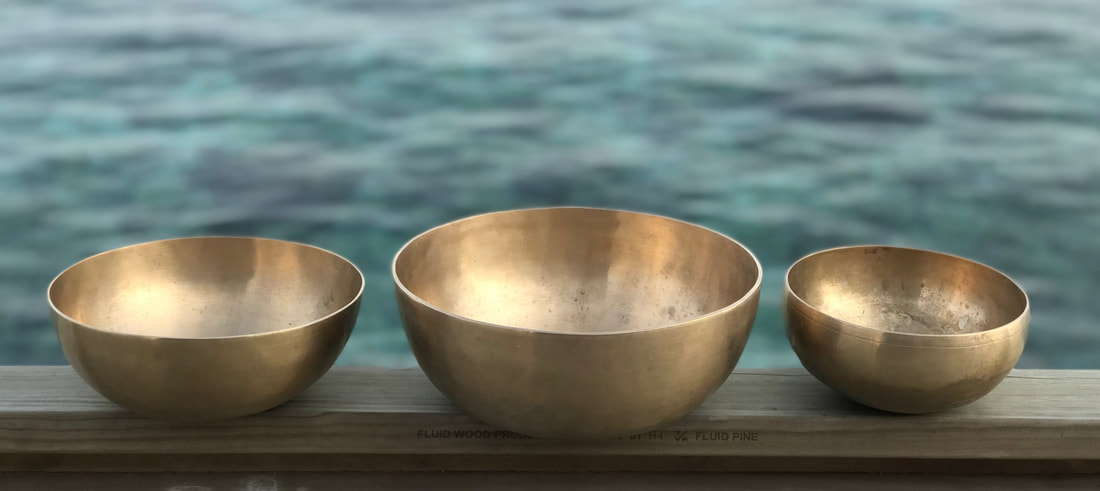
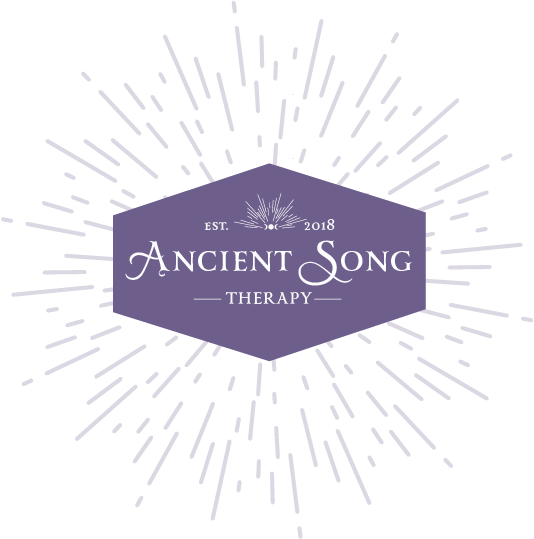


Frequencies